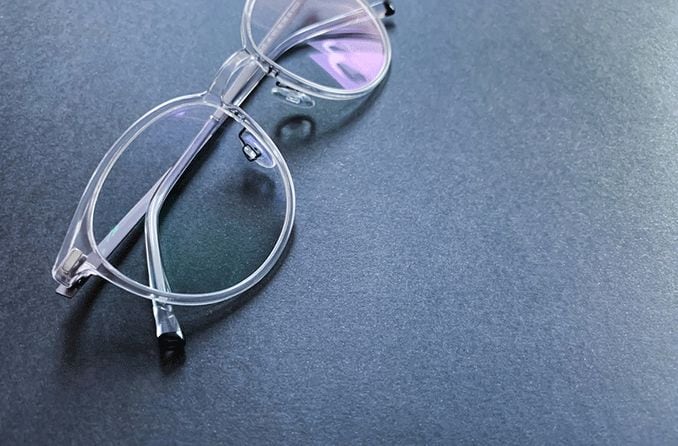Picking a new pair of frames is a great way to update your look without breaking the bank. While some glasses wearers are into having multiple pairs to mix and match with whatever’s in their closet, there are those who prefer one tried-and-true pair that will compliment anything.
Regardless of what category you fall in, a pair of clear eyeglass frames will fit the bill. The edgy yet universal appearance of clear frames makes them the perfect addition to your wardrobe.
What are clear glasses?
Clear eyeglasses, also called transparent or crystal glasses, describe glasses with clear, colorless (or almost colorless) frames.
Most transparent frames are made of a sturdy plastic material called Zyl (also known as zylonite, acetate or cellulose acetate) or propionate. Other plastic frame materials include nylon, polyamide, carbon, polycarbonate and a type of epoxy resin called Optyl.
Clear frames can be completely colorless, leaving them nearly invisible on your face, or have a slight tint of color to them.
Clear frames vs. clear lenses
The name “clear glasses” can describe the lenses (the material you look through) or the frames (the structure that holds the lenses and rests on your face). While the term can be used to describe both features, it’s important to understand the difference between them.
As mentioned above, clear frames are almost or completely clear. You can easily spot a pair of clear frames when compared to a pair of tortoiseshell or opaque frames.
“Clear lenses” is the term used to describe lenses that do not have any kind of prescription associated with them. Glasses with clear lenses might also be called “plano” or “fake” glasses. If you were to set a pair of clear-lensed glasses next to a pair of prescription eyeglasses, you likely would not be able to tell the difference between them unless the prescription lenses were particularly strong.
Clear-lensed glasses can be used as an accessory or as a means of protection. For instance, if you have perfect vision, but you have trouble with glare when driving at night, you would buy glasses with clear lenses and anti-reflective coating to reduce glare.
It’s possible to purchase clear frames with clear lenses or prescription lenses. However, if you require a prescription to correct any vision problems, you should avoid shopping for “clear lenses.”
SEE RELATED: How to choose the best lenses for your eyeglasses
Benefits of wearing clear-framed glasses
Clear eyeglass frames have steadily increased in popularity over the past few years. Celebrities such as Gigi Hadid, Samuel L. Jackson, Sarah Hyland and even America’s dad, Tom Hanks, have been seen sporting the discreetly stylish specs.
The appeal of transparent glasses is that they look good on pretty much everyone. They are complementary to any age, hair color, eye color or skin tone. Also, because they’re clear, the frames don’t distract from one’s facial features. Rather, they highlight the eyes and cheekbones.
Clear eyeglasses are also easy to pair with just about anything in your closet, regardless of the time of year. Their ability to transition from “work around the house” glasses to “night out on the town” glasses makes them hard not to love.
Picking the right frame shape for your face
While frame color (or lack thereof) may be universally flattering, to ensure you’re choosing the absolute best pair of glasses, it’s helpful to know what frame shape works best with your face shape.
There are seven types of face shapes, each with corresponding frame shapes that are the most complimentary:
- Oval – An oval-shaped face is considered “well-balanced,” which means most frame shapes will be flattering.
- Round – Angular frame shapes, including cat-eye, rectangular and geometric frames work best for a round face shape.
- Square – Frames with rounded edges, such as aviators or Clubmasters, counterbalance the strong, angular facial features.
- Heart – Thin, light-colored and rimless frames balance the wide forehead typically found in this face shape.
- Oblong – Similar to an oval face shape, many frame styles will look good on an oblong face. However, frames with a bold browline or semi-rimless frames help balance the length of your face.
- Diamond – Prominent cheekbones are seen in people with diamond-shaped faces. Cat-eye and semi-rimless frames pull the focus away from the cheeks and onto the eyes.
- Base-down triangle – Similar to those with a heart-shaped face, choosing frames that have bold, decorative browlines will emphasize the narrow upper third of your face.
